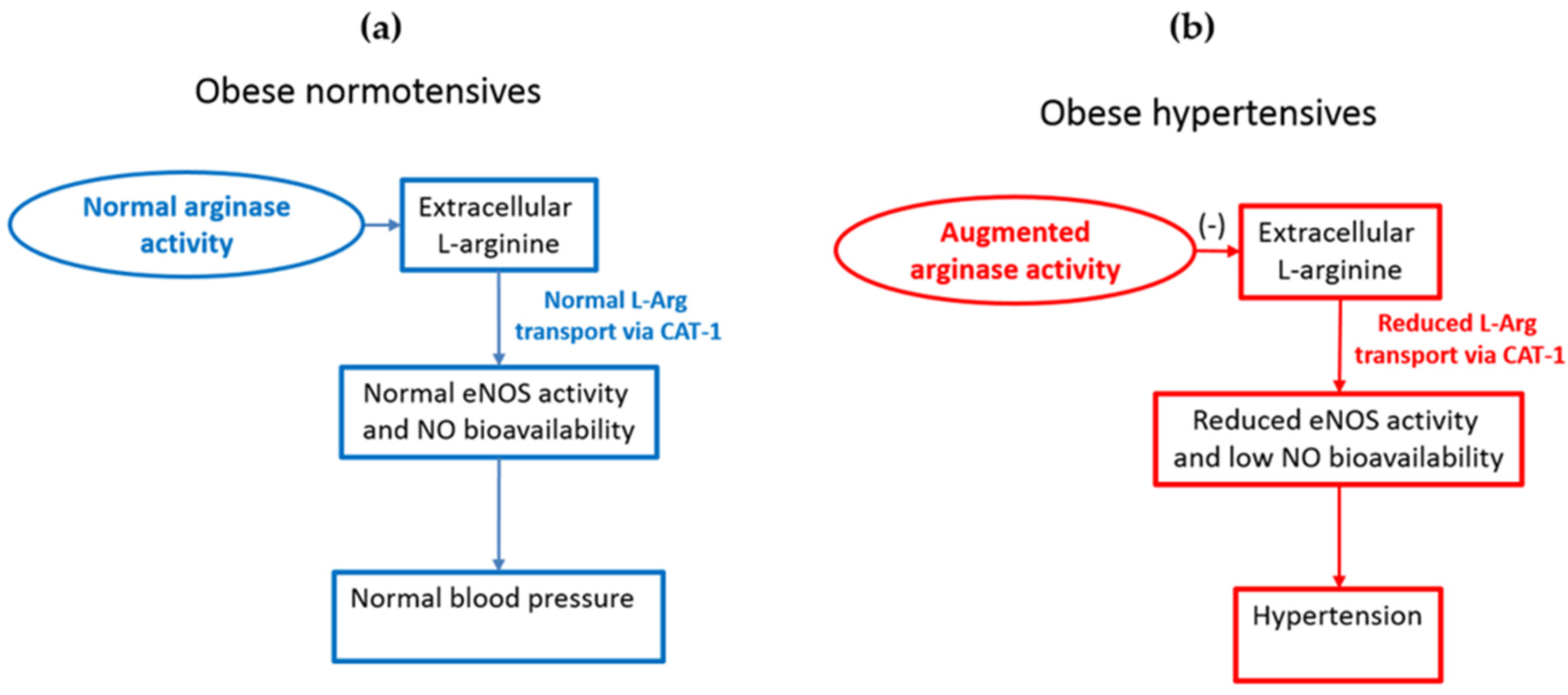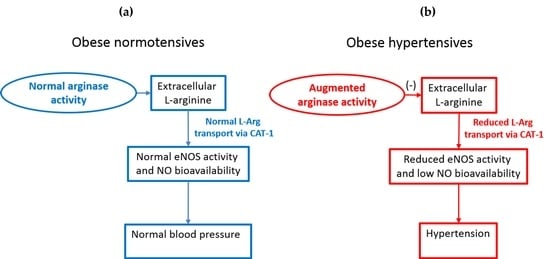Effects of Dietary l-Arginine on Nitric Oxide Bioavailability in Obese Normotensive and Obese Hypertensive Subjects
Abstract
:Author Contributions
Conflicts of Interest
Abbreviations
| NO | Nitric oxide |
| CAT-1 | Cationic amino acid transporter-1 |
| eNOS | Endothelial nitric oxide synthase |
| l-Arg | l-arginine |
References
- Rajapakse, N.W.; Head, G.A.; Kaye, D.M. Say no to obesity-related hypertension: Role of the l-arginine-nitric oxide pathway. Hypertension 2016, 67, 813–819. [Google Scholar] [CrossRef] [PubMed]
- Hall, J.E.; do Carmo, J.M.; da Silva, A.A.; Wang, Z.; Hall, M.E. Obesity-induced hypertension: Interaction of neurohumoral and renal mechanisms. Circ. Res. 2015, 116, 991–1006. [Google Scholar] [CrossRef] [PubMed]
- Vaněčková, I.; Maletínská, L.; Behuliak, M.; Nagelová, V.; Zicha, J.; Kuneš, J. Obesity-related hypertension: Possible pathophysiological mechanisms. J. Endocrinol. 2014, 223, R63–R78. [Google Scholar] [CrossRef] [PubMed]
- Mirmiran, P.; Bahadoran, Z.; Ghasemi, A.; Azizi, F. The association of dietary l-arginine intake and serum nitric oxide metabolites in adults: A population-based study. Nutrients 2016, in press. [Google Scholar]
- Rajapakse, N.W.; Karim, F.; Straznicky, N.E.; Fernandez, S.; Evans, R.G.; Head, G.A.; Kaye, D.M. Augmented endothelial-specific l-arginine transport prevents obesity-induced hypertension. Acta Physiol. 2014, 212, 39–48. [Google Scholar] [CrossRef] [PubMed]
- Sledzinski, T.; Sledzinski, M.; Smolenski, R.T.; Swierczynski, J. Increased serum nitric oxide concentration after bariatric surgery—A potential mechanism for cardiovascular benefit. Obes. Surg. 2010, 20, 204–210. [Google Scholar] [CrossRef] [PubMed]
- Chin-Dusting, J.P.; Willems, L.; Kaye, D.M. l-arginine transporters in cardiovascular disease: A novel therapeutic target. Pharmacol. Ther. 2007, 116, 428–436. [Google Scholar] [CrossRef] [PubMed]
- Kakoki, M.; Wang, W.; Mattson, D.L. Cationic amino acid transport in the renal medulla and blood pressure regulation. Hypertension 2002, 39, 287–292. [Google Scholar] [CrossRef] [PubMed]
- Johnson, F.K.; Peyton, K.J.; Liu, X.M.; Azam, M.A.; Shebib, A.R.; Johnson, R.A.; Durante, W. Arginase promotes endothelial dysfunction and hypertension in obese rats. Obesity 2015, 23, 383–390. [Google Scholar] [CrossRef] [PubMed]
- El Assar, M.; Angulo, J.; Santos-Ruiz, M.; de Adana, J.C.R.; Pindado, M.L.; Sánchez-Ferrer, A.; Hernández, A.; Rodríguez-Mañas, L. Asymmetric dimethylarginine (ADMA) elevation and arginase up-regulation contribute to endothelial dysfunction related to insulin resistance in rats and morbidly obese humans. J. Physiol. 2016, in press. [Google Scholar]

© 2016 by the authors; licensee MDPI, Basel, Switzerland. This article is an open access article distributed under the terms and conditions of the Creative Commons Attribution (CC-BY) license (http://creativecommons.org/licenses/by/4.0/).
Share and Cite
Giam, B.; Kuruppu, S.; Head, G.A.; Kaye, D.M.; Rajapakse, N.W. Effects of Dietary l-Arginine on Nitric Oxide Bioavailability in Obese Normotensive and Obese Hypertensive Subjects. Nutrients 2016, 8, 364. https://doi.org/10.3390/nu8060364
Giam B, Kuruppu S, Head GA, Kaye DM, Rajapakse NW. Effects of Dietary l-Arginine on Nitric Oxide Bioavailability in Obese Normotensive and Obese Hypertensive Subjects. Nutrients. 2016; 8(6):364. https://doi.org/10.3390/nu8060364
Chicago/Turabian StyleGiam, Beverly, Sanjaya Kuruppu, Geoffrey A. Head, David M. Kaye, and Niwanthi W. Rajapakse. 2016. "Effects of Dietary l-Arginine on Nitric Oxide Bioavailability in Obese Normotensive and Obese Hypertensive Subjects" Nutrients 8, no. 6: 364. https://doi.org/10.3390/nu8060364





